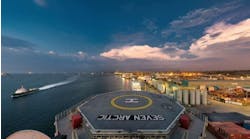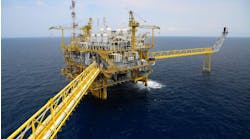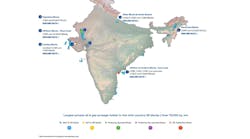Gene Kliewer • Houston
Pazflor orders placed
Pazflor development contracts are being let. Oceaneering International Inc. has won a $15-million contract with FMC Kongsberg Subsea AS to supply umbilicals for the project.
The order is for three umbilicals totaling 11,800 m (38,714 ft) in length to be installed as part of FMC Technologies’ subsea gas/liquid separation system. The umbilicals will mornsupply electrical power to subsea pumps and the separation system’s control pod, lubrication to the subsea pumps, and hydraulic pressure to valve actuators. They also will provide flow assurance chemicals and control signals to the subsea separation system.
Manufacture of the umbilicals, which include electric power cables, steel tubes, and fiber optics, is scheduled for the Oceaneering Multiflex facility in Panama City, Florida. Delivery is scheduled for 2010.
Under terms of the contract Oceaneering will also purchase and provide to FMC Technologies over 200 buoyancy modules to be used in the installation of the umbilicals.
Grenland Group has signed a letter of intent with FMC Technologies for the fabrication, assembly, and testing of subsea structures for Pazflor .
The $31.8-million contract is for fabrication and assembly of subsea structures weighing a total of 1,200 metric tons (1,322 tons) in Grenland and in Tonsberg.
Deliveries are expected to begin in 2009.
Some 150 km (93 mi) off the coast of Angola and in water depths of 600 to 1,200 m (1,968 to 3,937 ft), the Pazflor development will bring the Perpetua, Hortensia, and Zinia (Upper Miocene), and Acacia (Oligocene) fields into production.
The overall development program uses techniques applied on Girassol and Dalia. An FPSO will receive oil and natural gas from 25 subsea production wells, with an additional 22 water injector and two natural gas injector wells. The FPSO will have a processing capacity of 200,000 b/d of oil and can store 2 MMbbl, bringing the installed production capacity on block 17 to over 700,000 b/d.
The Pazflor development is scheduled to start production in 2011.
Total E&P Angola is the operator (40%). Esso Exploration Angola (Block 17) Ltd. (20%), BP Exploration (Angola) Ltd. (16.67%) and StatoilHydro (23.33%) are partners.
White Rose subsea systems set
Cameron has secured a $235-million contract to engineer, construct, and provide installation support for subsea systems at the North Amethyst project, a tieback development that is part of the White Rose oil field offshore Newfoundland and Labrador, Canada.
Cameron will provide 13 subsea wellheads and christmas trees, control systems, manifold components, flowline connection systems, and engineering and project management support.
Initial equipment deliveries are slated to begin in the first quarter of 2009, with installation to be completed by year-end 2009.
“We have provided more than 20 subsea production systems for the initial stages of the development of the White Rose field, and we welcome the opportunity to continue our support in this region,” says Jack B Moore, Cameron president and CEO.
New test center planned
VetcoGray, a GE Oil & Gas business, plans to build a, multi-million dollar hyperbaric test center at the company’s Nailsea, UK, site.
Located next to the existing assembly and test facilities, the new test center will have hyperbaric (high-pressure oxygen) technology to simulate operational conditions at the seabed. VetcoGray’s subsea control modules will be tested to identify any dormant fault conditions that otherwise would be detected only after seabed installation.
“Over the next five years, most of our projects will involve testing of equipment at depths of 3,000 m (9,842 ft),” says Dave Tucker, COO of VetcoGray, “but the trend in the industry is toward applications in deeper water. Our new facility will have a test capability of 4,000 m (13,123 ft), enabling us to address the future needs of our customers.”
A full-time project manager has been appointed to oversee the planning permission phase leading up to the first production test scheduled for April 2009.
The new center will incorporate a hyperbaric test chamber including a control system, a test hydraulic power unit, an electronic test unit, and data loggers. The facility also will provide space for enhanced system integration tests.
Total lets IRM contract for North Sea
Total E&P UK Ltd. has contracted Subsea 7 Inc. an exclusive five-year contract for inspection, repair, and maintenance (IRM) work in the northern and central North Sea. The contract is valued at approximately $60 million.
Subsea 7 is to provide IRM services which include onshore support comprising project management, engineering, and general support for underwater operations through to post-job reporting. Offshore services will include diving, remotely operated vehicles (ROVs) and associated support activities.
The contract, effective immediately, covers the Alwyn, Dunbar, Otter, Forvie, Nuggets, Frigg, Ellon, Grant, Jura, and Elgin / Franklin fields with the potential to extend to Laggan, West of Shetland. It will be performed at Subsea 7’s offices in Aberdeen for an initial five-year period with two, one-year options.
Subsea 7 Inc. also announced formation of a joint venture company with Richtech International Holding Inc., a Chinese engineering consultancy, to provide subsea front-end engineering and design, detailed design, integrity management, and engineering consulting services to operators. The company will be known as Subsea Engineering Solutions.
Subsea 7 says its objective for SES is to extend its service offering to clients and expand its capability to provide engineering support, in particular to the increasing number of deepwater engineering, procurement, installation, and commissioning (EPIC) projects being undertaken by the global oil and gas industry.
Drawing on the partner companies, SES will offer the disciplines of pipelines, structures, field layouts, and controls for the construction and operation of subsea assets. The company will operate independently under its own brand.
ConocoPhillips has invited both Norwegian and international contractors to bid on front-end engineering and development (FEED) for the Greater Ekofisk Area. If the project goes forward, the scope of work includes integration of a new Ekofisk accommodation platform with bridge supports and bridges, a new wellhead platform including subsea water injection facilities, and two new platforms, pipelines, and cables to tie in the new facilities to the existing Eldfisk platforms.
ConocoPhillips and the Ekofisk owners are working continuously on possibilities that will increase production and the recovery rate for the fields in the Ekofisk area. The planned FEED work aims to define and mature possible ways to increase production and boost the recovery rate of the field.




